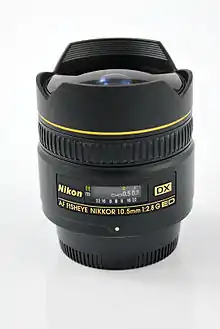Nikon AF DX Fisheye-Nikkor 10.5mm f/2.8G ED
The AF DX Fisheye-Nikkor 10.5mm f/2.8G ED is a fisheye lens manufactured by Nikon for use on Nikon DX format digital SLR cameras. It provides a full 180-degree angle of view on a DX format camera.
 | |
| Maker | Nikon |
|---|---|
| Technical data | |
| Focal length | 10.5mm |
| Crop factor | 1.5 |
| Aperture (max/min) | f/2.8 - f/22 |
| Close focus distance | 0.14m |
| Max. magnification | 1:5 |
| Diaphragm blades | 7 (rounded) |
| Construction | 10 elements in 7 groups |
| Features | |
| Ultrasonic motor | |
| Lens-based stabilization | |
| Macro capable | |
| Application | Fisheye |
| Physical | |
| Max. length | 62.5mm |
| Diameter | 63mm |
| Weight | 305g |
| Filter diameter | Rear gelatin type |
| Accessories | |
| Lens hood | Built in |
| Case | CL-00715 |
| Angle of view | |
| Diagonal | 180° (with DX format) |
| History | |
| Introduction | 2003 |
Introduction
Nikon announced the lens on 22 July 2003.[2] It was the first prime lens released by Nikon specifically designed for Nikon DX format DSLR cameras. The lens produces a distinctive rectangular fisheye image, which fills the DX format frame (as opposed to a circular fisheye lens which produces a circular image). The lens does not support autofocus on the D40, D40X, D60, D3000, and D5000 as it does not have a built-in focus motor.
Features
- 10.5mm focal length (approximately equivalent to a 16mm lens used on a 135 film format camera).
- Nikon F-lens mount exclusively for use with Nikon DX format DSLRs.
- Full 180-degree angle of view.
- Rectangular fisheye image.
Construction
- 10 elements in 7 groups.
- 1 ED (extra low dispersion) glass element.
- Built-in hood.
- Rear gelatin filter (no front filter thread).
References
- "AF DX Fisheye-Nikkor 10.5mm f/2.8G ED". Lenses. Nikon Corporation. 2009. Archived from the original on 2011-03-20. Retrieved 2010-06-22.
- "Two new wide Nikon DX Format lenses". Digital Photography Review. 22 July 2003. Retrieved 2009-02-23.
External links
- Fisheyes – III – The AF Fisheye-Nikkor 16 mm f/2.8D, by Pierre Toscani: an inverse ray tracing study of this lens, including its mapping function and the behavior of its entrance pupil.
This article is issued from Wikipedia. The text is licensed under Creative Commons - Attribution - Sharealike. Additional terms may apply for the media files.